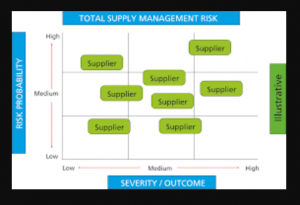
Supplier risk management (SRM) is a serious issue for procurement professionals. Suppliers can be unreliable, have poor quality products, or fail to meet specifications. In this blog post we will discuss AI / machine learning algorithms / techniques that you can use to manage supplier risk and make your procurement process more efficient.
What is supplier risk management?
Supplier Risk Management (SRM) also known as Supplier Risk Optimization (SRO), refers to policies and technology that enables organizations to manage risks related with suppliers. This can be done by analyzing data about past purchases from the supplier, predicting future risks related with purchases from this particular company. It’s crucial for procurement professionals understand SRM in order push better business decisions when it comes down to selecting new supplies or maintaining long-term relationships between different companies involved in supply chain processes.
What are different aspects of supplier risk management?
The following are different types of supplier related risks which, if not mitigated , can cause problems for procurement professionals:
- Supplier reliability: Suppliers can be unreliable (i.e., they fail to meet deadlines, provide misleading information) or have poor quality products (i.e., late deliveries). These issues can result in delays and additional costs for your procurement process.
- Supplier noncompliance: Supplier noncompliance with quality related specifications is yet another issue that can arise. This is especially important for companies that have strict quality standards, such as in the chemical industry or food manufacturing industry. Another compliance related risks can be purely associated with regulatory standards.
- Supplier capability: Suppliers might not be capable of producing the products you need at a high enough quality level and on time. When a supplier has limited production capacity, it can cause delays in the procurement process and problems with inventory management.
- Supplier financial risk: In addition to supplier reliability and capability issues, there are other risks that can lead to negative consequences. For example, suppliers might fail due to their own financial issues (e.g., bankruptcy). This could affect your procurement process.
- Supplier threat: Suppliers can pose a risk to you and/or your organization for various reasons, such as the following examples: They might share confidential information with competitors or fail to protect it correctly; they might be experiencing financial difficulties due to cyber-attacks that result in losses of money, sensitive data, etc.
- Supplier demographic risk: The supplier’s demographic profile might be a source of concern. For example, suppliers located in certain countries or regions can pose higher risks due to economic and political instability (e.g., Syria, Afghanistan). Related to supplier demographic risk, suppliers located in areas where natural disasters are common can be problematic from a procurement perspective. For example, floods and earthquakes have been known to result in supply chain disruptions for companies that source products from countries having regular floods or earthquakes.
- Supplier social risk: Social risks related to the supplier’s workforce might also affect you as a procurement professional. For example, if the supplier’s workforce is not unionized they might be more willing to work in dangerous conditions or do excessive overtime without extra pay. This could affect your operations and lead to additional costs related with machine downtime or injuries that can happen because of hazardous working conditions. Another supplier social risk is their corporate social responsibility (CSR) profile and how it affects their organization. For example, suppliers that use child labor might be problematic for some companies because of strict ethical standards or internal policies. This could lead to machine downtime, delays in production, etc., which can affect your procurement process as a whole.
What are different machine learning techniques which can be applied to mitigate supplier risks?
The following are different machine learning techniques which can be applied to mitigate different risks:
- Predicting supplier reliability: Classification machine learning techniques can be applied to predict whether supplier is reliable enough or otherwise based on historical performance of the supplier. Supplier reliability depends upon several factors such as supplier’s financial health, supplier industry and its business cycle, etc. There will be needed a bunch of machine learning models which will be trained to assess supplier reliability. For example, the model predicting supplier reliability will take one of the inputs such as supplier financial risk from the model predicting supplier financial risk.
- Predicting supplier financial risk: Classification models can be used for predicting. which suppliers are likely to fail due to their own poor performance in the future based on different public data sources (e.g., bankruptcy reports, credit ratings). Some of the factors or features that determine supplier financial risk are supplier’s cash balance and debt levels, supplier’s creditworthiness as determined by their financial statements, supplier payment history including delinquency rates. Deep learning techniques can be applied to predict the financial health of a supplier based on their publicly available data.
What are some KPIs related to supplier risk management?
The following is a list of KPIs which can be measured to assess suppliers’ risks:
- Retention rate of suppliers in the category
- Supplier default rates
- Supplier CAPA (corrective and preventive actions) rates
AI / machine learning (ML) techniques are powerful tools to help procurement professionals mitigate supplier risks. Machine learning models can be used for predicting supplier reliability or financial health, based on different data sources. If you’re interested in learning more about how to use machine learning for your organization’s procurement strategies, don’t hesitate to contact us today!
- Mathematics Topics for Machine Learning Beginners - July 6, 2025
- Questions to Ask When Thinking Like a Product Leader - July 3, 2025
- Three Approaches to Creating AI Agents: Code Examples - June 27, 2025
I found it very helpful. However the differences are not too understandable for me